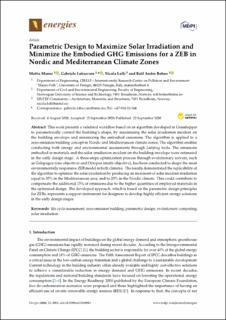| dc.contributor.author | Manni, Mattia | |
| dc.contributor.author | Lobaccaro, Gabriele | |
| dc.contributor.author | Lolli, Nicola | |
| dc.contributor.author | Bohne, Rolf André | |
| dc.date.accessioned | 2020-10-07T11:30:13Z | |
| dc.date.available | 2020-10-07T11:30:13Z | |
| dc.date.created | 2020-09-28T09:30:45Z | |
| dc.date.issued | 2020 | |
| dc.identifier.citation | Energies. 2020, 13 (18), . | en_US |
| dc.identifier.issn | 1996-1073 | |
| dc.identifier.uri | https://hdl.handle.net/11250/2681566 | |
| dc.description.abstract | This work presents a validated workflow based on an algorithm developed in Grasshopper to parametrically control the building’s shape, by maximizing the solar irradiation incident on the building envelope and minimizing the embodied emissions. The algorithm is applied to a zero-emission building concept in Nordic and Mediterranean climate zones. The algorithm enables conducting both energy and environmental assessments through Ladybug tools. The emissions embodied in materials and the solar irradiation incident on the building envelope were estimated in the early design stage. A three-steps optimization process through evolutionary solvers, such as Galapagos (one-objective) and Octopus (multi-objective), has been conducted to shape the most environmentally responsive ZEB model in both climates. The results demonstrated the replicability of the algorithm to optimize the solar irradiation by producing an increment of solar incident irradiation equal to 35% in the Mediterranean area, and to 20% in the Nordic climate. This could contribute to compensate the additional 15% of emissions due to the higher quantities of employed materials in the optimized design. The developed approach, which is based on the parametric design principles for ZEBs, represents a support instrument for designers to develop highly efficient energy solutions in the early design stages | en_US |
| dc.language.iso | eng | en_US |
| dc.publisher | MDPI | |
| dc.rights | CC BY 4.0 | * |
| dc.rights.uri | https://creativecommons.org/licenses/by/4.0/ | * |
| dc.subject | Life cycle assessment | en_US |
| dc.subject | Zero-emission building | en_US |
| dc.subject | Parametric design | en_US |
| dc.subject | Evolutionary computing | en_US |
| dc.subject | Solar irradiation | en_US |
| dc.title | Parametric Design to Maximize Solar Irradiation and Minimize the Embodied GHG Emissions for a ZEB in Nordic and Mediterranean Climate Zones | en_US |
| dc.type | Peer reviewed | en_US |
| dc.type | Journal article | en_US |
| dc.description.version | publishedVersion | en_US |
| dc.rights.holder | © 2020 The authors | en_US |
| dc.subject.nsi | VDP::Teknologi: 500 | en_US |
| dc.source.pagenumber | 18 | en_US |
| dc.source.volume | 13 | en_US |
| dc.source.journal | Energies | en_US |
| dc.source.issue | 18 | en_US |
| dc.identifier.doi | 10.3390/en13184981 | |
| dc.identifier.cristin | 1833940 | |
| cristin.ispublished | true | |
| cristin.fulltext | original | |
| cristin.qualitycode | 1 | |

